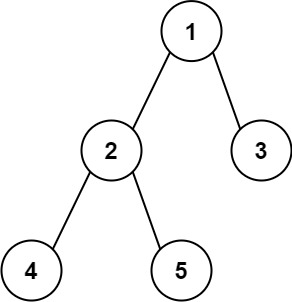Given the root of a binary tree, return the length of the diameter of the tree.
The diameter of a binary tree is the length of the longest path between any two nodes in a tree. This path may or may not pass through the root.
The length of a path between two nodes is represented by the number of edges between them.
Example 1:

Input: root = [1,2,3,4,5] Output: 3 Explanation: 3 is the length of the path [4,2,1,3] or [5,2,1,3].
Example 2:
Input: root = [1,2] Output: 1
Constraints:
[1, 104].-100 <= Node.val <= 100The core challenge of this problem is to find the longest path between any two nodes in a binary tree. This path does not necessarily have to pass through the root. The significance of this problem lies in its applications in network design, biology (e.g., finding the longest path in phylogenetic trees), and various other fields where tree structures are used.
Potential pitfalls include misunderstanding the definition of the diameter (it is the number of edges, not nodes) and not considering paths that do not pass through the root.
To solve this problem, we need to think about how to traverse the tree and calculate the longest path. A naive solution might involve checking all possible paths between nodes, but this would be highly inefficient.
Instead, we can use a depth-first search (DFS) approach to calculate the height of each subtree and use this information to determine the diameter. The height of a node is the number of edges on the longest path from the node to a leaf. The diameter can be found by considering the longest path that passes through each node.
The naive solution involves calculating the path length between all pairs of nodes, which is not optimal due to its high time complexity.
An optimized solution involves a single DFS traversal of the tree. During this traversal, we calculate the height of each node and update the diameter based on the sum of the heights of the left and right subtrees.
Here is a step-by-step breakdown of the optimized algorithm:
// Definition for a binary tree node.
function TreeNode(val, left, right) {
this.val = (val===undefined ? 0 : val);
this.left = (left===undefined ? null : left);
this.right = (right===undefined ? null : right);
}
var diameterOfBinaryTree = function(root) {
let diameter = 0;
// Helper function to calculate height
function height(node) {
if (node === null) return 0;
// Recursively find the height of left and right subtrees
let leftHeight = height(node.left);
let rightHeight = height(node.right);
// Update the diameter if the path through the current node is longer
diameter = Math.max(diameter, leftHeight + rightHeight);
// Return the height of the current node
return Math.max(leftHeight, rightHeight) + 1;
}
// Start the DFS traversal from the root
height(root);
return diameter;
};
The time complexity of this approach is O(n), where n is the number of nodes in the tree. This is because we visit each node exactly once during the DFS traversal. The space complexity is O(h), where h is the height of the tree, due to the recursion stack.
Potential edge cases include:
These cases are handled by the algorithm as it correctly calculates the height and updates the diameter accordingly.
To test the solution comprehensively, consider the following test cases:
Use a testing framework like Jest or Mocha to automate the testing process.
When approaching such problems, it is essential to:
In this blog post, we discussed how to find the diameter of a binary tree using an optimized DFS approach. We covered the problem definition, approach, algorithm, code implementation, complexity analysis, edge cases, and testing. Understanding and solving such problems is crucial for improving algorithmic thinking and coding skills.
For further reading and practice, consider the following resources:
Our interactive tutorials and AI-assisted learning will help you master problem-solving skills and teach you the algorithms to know for coding interviews.
Start Coding for FREE